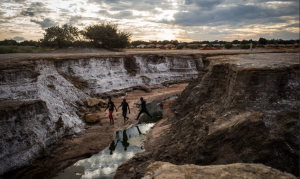 [posted by Todd C. Frankel on The Washington Post, February 28th, 2018] In Congo’s sun-scorched and dusty south, thousands of miners scour underground tunnels hunting for cobalt. Many of them work by hand. That’s why they are known as creuseurs — French for diggers.
[posted by Todd C. Frankel on The Washington Post, February 28th, 2018] In Congo’s sun-scorched and dusty south, thousands of miners scour underground tunnels hunting for cobalt. Many of them work by hand. That’s why they are known as creuseurs — French for diggers.
They don’t use power tools. They don’t wear face masks and often no gloves. They do it because they live in one of the poorest countries in the world, and cobalt is valuable. The mineral is essential for the lithium-ion batteries found in smartphones and many electric vehicles. Most of the world’s cobalt supply comes from the Congo region. These cobalt-laden chunks of rock leave the country destined for refineries in Europe and China, where they enter the complex supply chains of some of the largest technology and automotive firms.
Creuseurs know their work is physically dangerous. Death and injury from tunnel collapses are not uncommon. Children sometimes join their older brothers and fathers in the mines.
But what’s less understood are the environmental health risks posed by the extensive mining. Southern Congo holds not only vast deposits of cobalt and copper but also uranium. Scientists have recorded alarming radioactivity levels in some mining regions. Mining waste often pollutes rivers and drinking water. The dust from the pulverized rock is known to cause breathing problems. The mining industry’s toxic fallout is only now being studied by researchers, mostly in Lubumbashi, the country’s mining capital.
The mines provide much-needed work for the region’s millions of mostly impoverished residents. But the work’s toll on land and bodies is seen by many as devastating.
Last year, Lena Mucha, 34, a German photojournalist, met with people who were directly affected by the mining activities in the region. She met with mothers who had miscarriages and photographed infants born with deformities whose fathers worked in the mines.
Cobalt is mined all over the world, but 60 percent comes from Congo. As Mucha told In Sight, “we are all using cobalt … it’s difficult to not use it, but it’s important to let people know what is the story behind this.”
